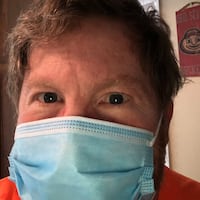The neighborhood, which has struggled recently, has a rich history as a home for hard-working people who were employed by nearby paper mills and factories before those closed down.
The plan calls for beautifying major streets through the neighborhood — especially Heaton Street and North Martin Luther King Boulevard — with more attractive crosswalks and sidewalks that also can have the effect of “calming” traffic to a slower pace. The plan also calls for more benches and street trees, plus safety improvements for pedestrians.
The students recommended “targeted revitalization efforts," particularly along Heaton Street, which has a properties that fill a spectrum of conditions from “Good” to “Extremely Poor," plus vacant lots. The neighborhood also has 28 historic buildings.
North End resident Jeff Gambrell, leader of RENEW (REvitalizing the North End from Within) said, “we think it opens the door for a lot of potential for the neighborhood.”
The part of the plan that most excites him and others includes considering the former Beckett Paper mill for an open-air farmers’ market similar to Cincinnati’s Findlay Market.
“The fact that the Miami students on their own thought of that as a potential opportunity as well really resonates with us,” Gambrell said.
Rising Up
“Our goal is to make sure that all of our neighborhoods are healthy, and safe, and vibrant,” said city Planning Director Liz Hayden. “That’s why we’re doing these plans, and trying to focus on these highly visible, important corridors in our neighborhoods, that if we can change a few blocks, make a big difference in the perception of these neighborhoods.”
The Miami students recognized blight is a problem in the neighborhood, Hayden said. The city has been encouraging property owners to paint their buildings, fix porches and get rid of trash and debris.
“And honestly, we’ve been demolishing some structures on Heaton this year,” she said. “Some of them are just too far gone.”
Entryway signs, perhaps even arches above streets, could welcome people to the neighborhood, the plan suggests. Another possibility is community gardens.
Brandon Saurber, the city’s director of neighborhoods, said the North End has some things it can build on. Top on the list is probably its proximity to the gigantic Spooky Nook project and other development.
Also, “the North End ballfields are such a gem,” and Spooky Nook can help shine a brighter light on them, he said. Spooky Nook staff already have hosted tournaments there.
On top of that, North End residents have a lot of pride.
“It’s up there with Lindenwald, as far as neighborhoods people are particularly proud to be from," Saurber said.
One building Hayden is hopeful about is at 345 N. 7th St., which has a few street-level storefronts: “It would be so cool if we could have that reactivated in a positive way,” she said. She and a co-worker recently met with the owners, “and they are excited to work with us to see if somebody would rent those spaces."
Started in a Park
A few things in recent years have helped energize the North End:
- RENEW was created
- Two teachers started an Art in the Park program for children at John R. Moser Park
- The park was beautified, with children’s playground equipment added, making it a gathering place. A monument also was created in memory of seven people killed in a fire — including four children from the same family — three decades ago.
City leaders and the StreetSpark program recently unveiled a dramatic, pink mural called Robros at 802 Heaton St., depicting two robot brothers designed by painter, illustrator and digital artist Logan Walden. The mural is a nod to the city’s industrial might, and the robots’ eyes illuminate when lights are on inside the building.
Hayden said the mural “has sparked more energy and interest from the property owner, who’s begun sprucing things up around his property, and also gotten neighbors excited and saying, ‘Hey, we’ve got to step up our game to make sure our property looks good, too.' That’s exactly the kind of positive energy we want to see.”
“If you walk along Heaton, you’ll see people doing projects,” she said. “Everything builds on the others.”
Dan Bates, president and CEO of the Greater Hamilton Chamber of Commerce, said he’s looking forward to seeing economic development spill out from the downtown and Main Street areas, which are seeing growth because of Spooky Nook.
Given the massive economic growth and the development of Spooky Nook, “we will only maximize that benefit if all the neighborhoods rise with the tide,” Bates said. “This is the window of opportunity we have where every neighborhood can benefit.”
About the Author



